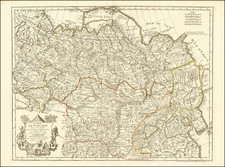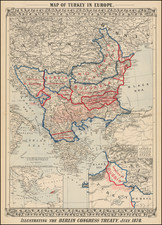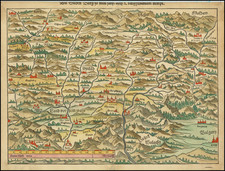Fine plan of the town of Tighina in Moldova, shown here with its Ottoman name, Bender.
The map shows Tighina at the time it was briefly retaken from the Ottomans by the Venetians in 1789.
Tighina
Tighina was first mentioned as an important customs post in a commerce grant issued by the Moldavian voivode Alexander the Good to the merchants of Lviv on October 8, 1408. The name "Tighina" is found in documents from the second half of the 15th century. The town was the main Moldavian customs point on the commercial road linking the country to Tatar Crimea. During his reign of Moldavia, Stephen III had a small wooden fort built in the town to defend the settlement from Tatar raids.
In 1538, the Ottoman sultan Suleiman the Magnificent conquered the town from Moldavia, and renamed it Bender. Its fortifications were developed into a full fortress under the same name under the supervision of the Turkish architect Koji Mimar Sinan. The Ottomans used it to keep the pressure on Moldavia. At the end of the 16th century several unsuccessful attempts to retake the fortress were made. In the summer of 1574 Prince John III the Terrible led a siege on the fortress, as did Michael the Brave in 1595 and 1600. About the same time the fortress was attacked by Zaporozhian Cossacks.
In the 18th century, the fort's area was expanded and modernized by the prince of Moldavia Antioh Cantemir, who carried out these works under Ottoman supervision. In 1713, the fortress, the town, and the neighboring village Varnița were the site of skirmishes between Charles XII of Sweden, who had taken refuge there with the Cossack Hetman Ivan Mazepa after his defeat in the Battle of Poltava in 1709, and the Turks who wished to enforce the departure of the Swedish king.
During the second half of the 18th century, the fortress fell three times to the Russians during the Russo-Turkish Wars (in 1770, 1789, and in 1806 without a fight).
Antonio Zatta (fl. 1757-1797) was a prominent Italian editor, cartographer, and publisher. Little is known about his life beyond his many surviving published works. It is possible that he was born as early as 1722 and lived as late as 1804. He lived in Venice and his work flourished between 1757 and 1797. He is best known for his atlas, Atlante Novissimo (1779-1785), and for his prolific output of prints and books that were both precisely made and aesthetically pleasing. Zatta clearly had a large network from which to draw information; this is how he was able to publish the first glimpse of the islands visited by Captain Cook in the Atlante Novissimo. Zatta also published books of plays and architecture.









![[Poland, Croatia, Slovenia, Hungary, Serbia, Romania, Ukraine, Bulgaria] (La discrittione della Transylvania et parte del l'Ungaria, et il simil della Romania)](https://storage.googleapis.com/raremaps/img/small/59225.jpg)
![[Balkans / Hungary] Regnorum Hungariae, Dalmatiae, Croatiae, Sclavoniae, Bosniae, Serviae et Principatus Transylvaniae novissima exhibitio facta A. Io. Bapt. Homann Norimb.](https://storage.googleapis.com/raremaps/img/small/89531.jpg)


![[Tighina / Bender, Moldavia -- Dniester River] Plan von der Festung Bendern am Dniester Flus, zwischen der Moldau, westlichen Nogai und Bessarabien an einen Morast gelegen](https://storage.googleapis.com/raremaps/img/small/61819.jpg)
